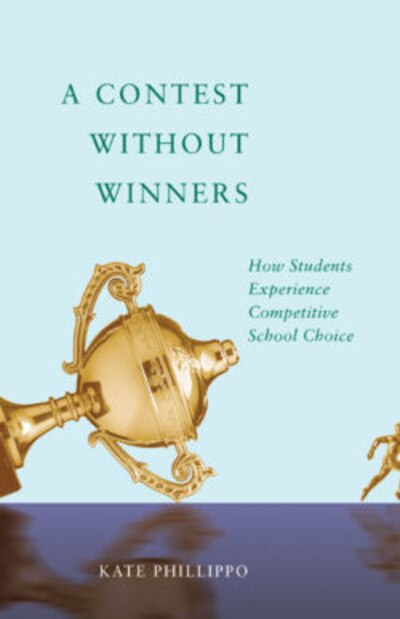Research so far on Chicago’s school choice policy has focused primarily on process and outcomes, not student experience. But “A Contest Without Winners,” a new book from a Loyola University Chicago researcher, takes a different approach.
In it, Kate Phillippo, an associate professor of cultural and educational policy studies in Loyola University Chicago’s School of Education, examines the experiences of 36 Chicago eighth-graders as they navigate the high-stakes application process for acceptance to high school. Click here to read Chalkbeat Chicago’s in-depth interview with Phillippo.
This excerpt focuses on the tension between choice and a student’s circumstances — and how family wealth and input can influence outcomes for some students and not others.
All of the names of students, teachers, and schools in Phillippo’s book are pseudonyms.
Rafeeq and Timothy both aspired to professional careers, Rafeeq as a computer engineer or pharmacist and Timothy as an accountant. They both hoped that high school would help point them in the right direction.
“I just want to learn a lot, be successful, and get a good job,” said Rafeeq.
Each qualified to apply to Chicago’s selective enrollment high schools and prioritized those schools early on. Each eschewed Edmunds, their neighborhood high school.
Timothy investigated only a few schools and did not even know that Edmunds was his open-enrollment neighborhood school until his school counselor, Ms. Richman, told him. When she asked whether he was interested, he responded, “Not really.”
“Not the IB program?” Ms. Richman countered [referring to the rigorous International Baccalaureate curriculum].
Unenthused, Timothy noncommittally said, “I could apply there.”
He later told his interviewer that Edmunds “doesn’t really provide much for me,” adding that he never considered applying.
Rafeeq’s search was similarly patchy. He attended open houses at two of Chicago’s most exclusive public high schools but never met with Mr. Menck, the teacher at Forrester who helped students research and apply to schools. Rafeeq applied to IB programs but did not attend their open houses, even though Chicago Public Schools required applicants to do so. Competitive choice demanded a level of anticipatory strategy, organization, and attention to detail that exceeded Timothy’s and Rafeeq’s capacities, even though each cared deeply about high school.
When Chicago Public Schools sent out admission notices, Rafeeq received only rejection and wait-list letters. He had nothing to contribute to the feverish conversations at Forrester about where students would go in the fall. The research team member who observed Rafeeq’s classroom that day commented that Rafeeq “didn’t say a thing. I think he was ashamed and confused and felt it best not to weigh in.”
In contrast, Timothy appeared content. He had known for weeks that he would attend St. Thomas, a private, all-boys school. “I was relieved that I got to find out a little bit earlier,” he explained. He did not have to report rejection to classmates at Vista, or be publicly identified with a high school that he or his peers considered inferior.

Rafeeq and Timothy both acted injudiciously while engaging with competitive school choice policy. They misunderstood key points of information, overestimated their academic qualifications, pursued the same schools that their friends liked, and declined or ignored suggestions from teachers or counselors.
Timothy spent 15 minutes in a mandatory individual counseling session with Ms. Richman, then brushed off her suggestions to apply to additional schools. “We just stuck with the same thing,” he recapped to me after their meeting.
The “we” in this comment, however, matters; Timothy used it to refer not to himself and his school counselor, but to himself and his mother. Timothy’s parents, and his mother in particular, who worked part-time, provided a powerful counterbalance while he stumbled through the application process.
Just before the deadline, Timothy and his parents pulled the plug on public high schools for him altogether. They had compared his grades and standardized test scores to those of students admitted to the schools on his list, and Timothy’s fell far below the previous year’s published cutoff scores.
Timothy’s father, a second-generation alumnus of St. Thomas, a private parochial school that stresses college preparation and entrepreneurial skill development, thought that legacy status would help Timothy gain admission. He reassured Timothy about the school’s admissions standards. “My dad said like 99 percent of the students get into St. Thomas even if they flunked the [admissions] test,” Timothy recalled.
His parents would not only pay St. Thomas tuition, upward of $10,000 per year, but they would also move across the city so that his sibling (rejected by selective enrollment high schools) could attend a neighborhood high school they considered superior to Edmunds.
Rafeeq counted on his parents too, but their support took the form of encouragement and expectations rather than capital-backed intervention. They could not research schools, Rafeeq explained, “because they don’t speak English, they don’t know much. So my sister helped me with most of my [application] stuff. And my sister’s friend, because she’s going to college now.”
His parents mainly insisted that he apply to schools that they agreed were good — by which they meant safe and academically challenging. Rafeeq’s family had fewer resources than Timothy’s did, though, so they could direct him only from a perspective of hopefulness and care.
However, Timothy’s parents did more than hope or care. They deployed knowledge of local private and public schools as well as their social capital, time, and money to ensure that Timothy would neither open a mailbox full of rejection letters nor attend a school that they all considered subpar.
Timothy behaved no more strategically than Rafeeq, but his parents were able to intervene. They had influence and cash to sling—and sling they did.
Rafeeq and Timothy navigated competitive high school choice with little prowess and even less mettle. Left on his own, each would have scrutinized an insufficient number of options, and probably only those with highly questionable likelihoods of acceptance. (In fact, that’s exactly what Rafeeq did.) Yet they found themselves on dramatically different trajectories after each completed the choice process.
Read more: On anxiety-filled day, slightly more Chicago students will get their first choice of high school
Differences in intelligence or initiative do not explain this outcome. The two young men shared a motivation to attend a “good” high school, and they tried hard, in their own view, to do so. They shared developmental characteristics, however, that led them to understandable, but unwise, judgments and actions during the application process. In other words, they were equally developmentally vulnerable to competitive choice policy.
Differences in competitive choice outcomes here came down to students’ divergent access to family capital that could, if available, buffer them against competitive choice policy’s harsher side. Family capital’s role in protecting students from competitive choice’s downsides is disturbing, especially in light of Chicago’s increasing income inequality and spiraling competition to access high-performing public schools.
These outcomes inform three conclusions. First, competitive choice works at cross purposes to healthy adolescent development. It discourages young people’s developmentally necessary risk taking, identity exploration, and independence from parents at times where these steps are critical in their lives.
Second, by cognitively overwhelming high school applicants and then setting them on rigid, formulaically determined academic tracks, competitive choice systematically sabotages its own efforts to meet students’ individual needs.
Third, competitive choice poses risk to young people who can’t count on family resources to protect them from unwanted admissions results.
Excerpted from “A Contest without Winners: How Students Experience Competitive School Choice” by Kate Phillippo. Published by the University of Minnesota Press and reprinted here by permission. Copyright 2019 by the Regents of the University of Minnesota.

